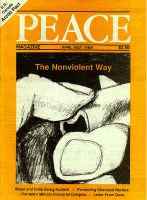
Peace Magazine Apr-May 1988, page 24. Some rights reserved.
Search for other articles by Gillian Thomas here
Janis Alton, Eric Fawcett, L. Terrell Gardner eds., Toronto/Fort Myers: Science for Peace/Stevens and Co, 1988
THE EVOCATIVE TITLE OF THIS COLLECTION OF papers from the 1985 Toronto Science for Peace Lectures is from The Pilgrim's Progress, suggesting a connection between these lectures and the great seventeenth century movement of religious and political dissent that turned the world upside down. The political and religious climate that gave us Bunyan also gave us the Diggers, the Ranters, the Shakers and the Quakers. Dangerous radicals all, in the eyes of those in power; some, like the Diggers, were battered into oblivion, while others, like the Quakers, still annoy the consciences of the complacent.
In contrast with these dangerous seventeenth century radicals, the Canadian peace movement is nearly obsessed with the issue of "credibility." We have groups from professions that enjoy high social status: physicians, engineers, lawyers. We have become fond of quoting military men who have reversed their views upon retirement. Our faith in the "credibility" of these groups is confirmed by the fact that both print and electronic journalists find their views acceptable. Public credibility is a product of one's connections with a conservative establishment, parallel with, rather than counter to, the defence establishment.
The contradiction is evident in this often useful collection of essays. For example, the feminist analysis of militarism has played an important role in the modern peace movement, as it did in that of the early 1900s which foresaw, but failed to prevent, World War I. Of the fifty-five participants in the Toronto lecture series, only eight were women, and of the twelve essays included in this collection only one is by a woman. The different perspective women bring to the analysis of war and peace is largely missing from this collection.
Instead, we have from Anatol Rapoport a thoughtful discussion on how universities may be persuaded to turn more attention to peace, and from David Parnas, who was one of the first scientists to declare SDI unworkable, an essay on SDI as a violation of "professional responsibility." Parnas sums up his position on continuing to act as a consultant in the development of new (non-SDI) software for weapons systems thus:
"I consider it vital that people with a strong sense of social responsibility continue to work within the military industrial complex. I do not want to see that power in the hands of people who are not conscious of social responsibility."
But the hawks in the defence establishment claim to have a deep sense of "social responsibility." The rest of us are not consoled to be told that sophisticated weapons systems are being designed only by those whose hearts are in the right place.
More useful are James A. Graff's analysis of "terrorism," and James Wilkes' account of TV fundamentalists' promotion of the "rapturing up" of the right wing faithful before a nuclear Armageddon. Graeme MacQueen's essay argues eloquently the links between nuclearism, public lying and machismo posturing. Like Noam Chomsky, he takes Vietnam as his text and is so caught in its rage and pain that the world of the late 1980s fades. He reminds us of Canadian complicity in Vietnam, a theme which Norman Rubin updates with his account of how tritium from Candu reactors became a product with commercial value as the essential "trigger" for nuclear weapons.
Peace activists will find these essays useful background as we try to expose the public lies on which "defence" policy is based. Our task, however, requires vision as well as information and reasoned arguments. For that, we may have to take up with less respectable, less "credible" company. p
Gillian Thomas is an English professor at Acadia University.

Peace Magazine Apr-May 1988, page 24. Some rights reserved.
Search for other articles by Gillian Thomas here